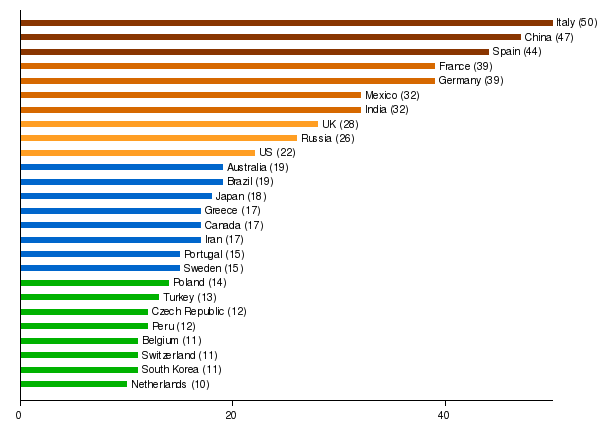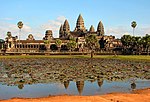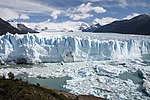World Heritage Site
From Wikipedia, the free encyclopedia
A UNESCO World Heritage Site is a place (such as a forest, mountain, lake, island, desert, monument, building, complex, or city) that is listed by the United Nations Educational, Scientific and Cultural Organization (UNESCO) as of special cultural or physical significance (see list of World Heritage Sites).[1] The list is maintained by the international World Heritage Programme administered by the UNESCO World Heritage Committee, composed of 21 UNESCO member states which are elected by the General Assembly.[2]
The programme catalogues, names, and conserves sites of outstanding cultural or natural importance to the common heritage of humanity. Under certain conditions, listed sites can obtain funds from the World Heritage Fund. The programme was founded with the Convention Concerning the Protection of the World Cultural and Natural Heritage,[3]which was adopted by the General Conference of UNESCO on 16 November 1972. Since then, 191 states parties have ratified the Convention, making it one of the most adhered to international instruments. Only Liechtenstein, Nauru, Somalia, South Sudan, Timor-Leste and Tuvalu are not Party to the Convention.
As of 2014, 1007 sites are listed: 779 cultural, 197 natural, and 31 mixed properties, in 161 states parties.[4][5] By sites ranked by country, Italy is home to the greatest number of World Heritage Sites with 50 sites, followed by China (47), Spain (44), France (39), Germany (39), Mexico (32) and India (32). UNESCO references each World Heritage Site with an identification number; however, new inscriptions often include previous sites now listed as part of larger descriptions. As a result, the identification numbers exceed 1,200 even though there are fewer on the list.
While each World Heritage Site remains part of the legal territory of the state wherein the site is located, UNESCO considers it in the interest of the international community to preserve each site.
See also: Lists of World Heritage Sites
Contents
[hide]History[edit]
See also: World Heritage Committee
| Signed | 16 November 1972 |
|---|---|
| Location | Paris, France |
| Effective | 17 December 1975 |
| Condition | 20 ratifications |
| Ratifiers | 191 (187 UN member states plus theCook Islands, the Holy See, Niue andPalestine) |
| Depositary | Director-General of the United Nations Educational, Scientific and Cultural Organization |
| Languages | Arabic, English, French, Russian and Spanish |
In 1954, the government of Egypt decided to build the Aswan Dam (Aswan High Dam), an event that would deluge a valley containing treasures of ancient Egypt such as the Abu Simbel temples. UNESCO then launched a worldwide safeguarding campaign. The Abu Simbel and Philae temples were taken apart, moved to a higher location, and put back together piece by piece. Meanwhile, the Temple of Dendur was moved to Metropolitan Museum of Art in New York City and the Temple of Debod was moved to Parque del Oeste in Madrid.
The cost of the project was US$80 million, about $40 million of which was collected from 50 countries. The project was regarded as a success, and led to other safeguarding campaigns, saving Venice and its lagoon in Italy, the ruins of Mohenjo-daro in Pakistan, and the Borobodur Temple Compounds in Indonesia. UNESCO then initiated, with the International Council on Monuments and Sites, a draft convention to protect the common cultural heritage of humanity.
Convention and background[edit]
The United States initiated the idea of cultural conservation with nature conservation. A White House conference in 1965 called for a 'World Heritage Trust' to preserve "the world's superb natural and scenic areas and historic sites for the present and the future of the entire world citizenry." The International Union for Conservation of Nature developed similar proposals in 1968, and they were presented in 1972 to the United Nations conference on Human Environment in Stockholm. Under the World Heritage Committee signatory countries are required to produce and submit periodic data reporting providing the World Heritage Committee with an overview of each participating nation's implementation of the World Heritage Convention and a "snapshot" of current conditions at World Heritage properties.
A single text was agreed on by all parties, and the Convention concerning the Protection of the World Cultural and Natural Heritage was adopted by the General Conference of UNESCO on 16 November 1972.
The Convention came into force on 17 December 1975. As of June 2014, it has been ratified by 191 states, which includes 187 UN member states plus the Cook Islands, the Holy See, Niue, and the Palestinian territories.[6]
Nominating process[edit]
A country must first take an inventory of its significant cultural and natural properties. This is called the Tentative List. A country may not nominate properties that have not been included on the Tentative List. Next, it can select a property from this list to place into a Nomination File.
At this point, the file is evaluated by the International Council on Monuments and Sites and the World Conservation Union. These bodies then make their recommendations to the World Heritage Committee. The Committee meets once per year to determine whether or not to inscribe each nominated property on the World Heritage List, and sometimes defers the decision to request more information from the country who nominated the site. There are ten selection criteria – a site must meet at least one of them to be included on the list.
Selection criteria[edit]
Until the end of 2004, there were six criteria for cultural heritage and four criteria for natural heritage. In 2005, this was modified so that there is only one set of ten criteria. Nominated sites must be of "outstanding universal value" and meet at least one of the ten criteria.[7]
Cultural criteria[edit]
- "represents a masterpiece of human creative genius"
- "exhibits an important interchange of human values, over a span of time, or within a cultural area of the world, on developments in architecture or technology, monumental arts, town-planning, or landscape design"
- "to bear a unique or at least exceptional testimony to a cultural tradition or to a civilization which is living or which has disappeared"
- "is an outstanding example of a type of building, architectural, or technological ensemble or landscape which illustrates a significant stage in human history"
- "is an outstanding example of a traditional human settlement, land-use, or sea-use which is representative of a culture, or human interaction with the environment especially when it has become vulnerable under the impact of irreversible change"
- "is directly or tangibly associated with events or living traditions, with ideas, or with beliefs, with artistic and literary works of outstanding universal significance"
Natural criteria[edit]
- "contains superlative natural phenomena or areas of exceptional natural beauty and aesthetic importance"
- "is an outstanding example representing major stages of Earth's history, including the record of life, significant on-going geological processes in the development of landforms, or significant geomorphic or physiographic features"
- "is an outstanding example representing significant on-going ecological and biological processes in the evolution and development of terrestrial, fresh water, coastal and marine ecosystems, and communities of plants and animals"
- "contains the most important and significant natural habitats for in-situ conservation of biological diversity, including those containing threatened species of outstanding universal value from the point of view of science or conservation"
Legal status of designated sites[edit]
UNESCO designation as a World Heritage Site provides prima facie evidence that such culturally sensitive sites are legally protected pursuant to the Law of War, under the Geneva Convention, its articles, protocols and customs, together with other treaties including the Hague Convention for the Protection of Cultural Property in the Event of Armed Conflict and international law.
Thus, the Geneva Convention treaty promulgates:
"Article 53. PROTECTION OF CULTURAL OBJECTS AND OF PLACES OF WORSHIP. Without prejudice to the provisions of the Hague Convention for the Protection of Cultural Property in the Event of Armed Conflict of 14 May 1954,' and of other relevant international instruments, it is prohibited:[9]
- (a) To commit any acts of hostility directed against the historic monuments, works of art or places of worship which constitute the cultural or spiritual heritage of peoples;
- (b) To use such objects in support of the military effort;
- (c) To make such objects the object of reprisals."
Statistics[edit]
See also: Table of World Heritage Sites by country, List of World Heritage Sites, List of World Heritage in Danger and List of World Heritage Sites by year of inscription
There are 981 World Heritage Sites located in 160 States Party. Of these, 759 are cultural, 193 are natural and 29 are mixed properties. The World Heritage Committee has divided the countries into five geographic zones: Africa, Arab States (composed of most of the Middle East and North Africa), Asia and Oceania, Europe & North America (includes Canada and the United States) and Latin America & Caribbean.
Russia and the Caucasus states are classified as European, while Mexico is classified as belonging to the Latin America & Caribbean zone, despite its location in North America. The UNESCO geographic zones also give greater emphasis on administrative, rather than geographic associations. Hence, Gough Island, located in the South Atlantic, is part of the Europe & North America region because the government of the United Kingdom nominated the site.
The table below includes a breakdown of the sites according to these zones and their classification:[10][11]
| Zone | Natural | Cultural | Mixed | Total |
|---|---|---|---|---|
| Americas and Europe | 68 | 417 | 11 | 496[12] |
| Asia and Oceania | 55 | 148 | 10 | 213[12] |
| Africa | 39 | 48 | 4 | 91 |
| Arab States | 5 | 67 | 2 | 74 |
| Latin America and the Caribbean | 36 | 91 | 3 | 130 |
| Sub-total | 203 | 771 | 30 | 1004 |
| less duplicates* | 15 | 26 | 1 | 42 |
| Total | 188 | 745 | 29 | 962 |
* Because many sites belong to more than one country, duplicates exist when counting them by country and within a region. For a table with by-country statistics, see: Table of World Heritage Sites by country.
Territorial division[edit]
Note: this overview lists only countries with ten or more World Heritage Sites.
- Brown: nations with 40 or more heritage sites
- Light brown: nations with 30 to 39 heritage sites
- Orange: nations with 20 to 29 heritage sites
- Blue: nations with 15 to 19 heritage sites
- Green: nations with 10 to 14 heritage sites

See also[edit]
References[edit]
- ^ "World Heritage".
- ^ "The World Heritage Committee". UNESCO World Heritage Site. Retrieved 14 October2006.
- ^ Convention Concerning the Protection of World Cultural and Natural Heritage
- ^ World Heritage List, UNESCO World Heritage Sites official sites.
- ^ Sites in Germany and Italy bring to 19 the number of sites inscribed on the World Heritage List this year, UNESCO World Heritage Sites official sites.
- ^ Convention concerning the Protection of the World Cultural and Natural Heritage: Treaty status.
- ^ "Criteria for Selection". World Heritage. Retrieved 14 October 2006.
- ^ "UNESCO World Heritage, The Criteria for Selection".
- ^ UN General Assembly (1979) [8 June 1977]. "UN Treaty No. 17512" (PDF). 'Volume 1125-1' UN. p. 27.
- ^ Stats
- ^ World Heritage List
- ^ a b The Uvs Nuur basin located in Mongolia and Russia is here included in Asia-Pacific zone.
External links[edit]
| Wikimedia Commons has media related to World Heritage Sites. |
| Wikivoyage has a travel guide for UNESCO World Heritage List. |
- UNESCO World Heritage portal – Official website (English) and (French)
- The World Heritage List – Official searchable list of all Inscribed Properties
- KML file of the World Heritage List – Official KML version of the list for Google Earth and NASA Worldwind
- Official overview of the World Heritage Forest Program
- Convention Concerning the Protection of the World Cultural and Natural Heritage – Official 1972 Convention Text in 7 languages
- The 1972 Convention at Law-Ref.org – Fully indexed and crosslinked with other documents
- Protected Planet — View all natural world heritage sites in the World Database on Protected Areas
- World Heritage Site – Smithsonian Ocean Portal
- Time magazine. The Oscars of the Environment – UNESCO World Heritage Site
- UNESCO chair in ICT to develop and promote sustainable tourism in World Heritage Sites




















No comments:
Post a Comment